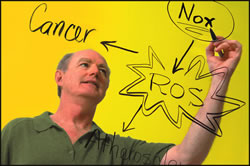

Illustration by Josef Gast

When normally benign Nox enzymes run amok, they create reactive oxygen, which encourages development of cancer and heart disease.



Abnormal cell growth directed by the Nox family can be reversed.

In this issue
From the CEO / LettersPromises writ in stone
Taking care of people
Taming the obNOXious enzyme
Moving forward
Noteworthy
On Point:
Communicating medical errors

by Holly Korschun
Pathologist David Lambeth and other Emory scientists have discovered
a new family of enzymes called "Nox" that seem to play major roles in
the development of several kinds of cancer and cardiovascular disease.
Their insights into this overachieving family have created a flurry of international scientific excitement and spawned a new field of research. And these scientists' efforts to understand Nox enzymes represent an exciting example of how years of basic science and genomic advances can realize their promise when sparked by fortuitous cross-disciplinary and translational collaborations.
Nox enzymes are found in a variety of cell types and tissues where they react with oxygen to generate "reactive oxygen," free radical forms of oxygen that have long been implicated in causing damage to cellular molecules such as DNA. While scientists have speculated that reactive oxygen is involved in mutations and tissue damage in diseases such as cancer and rheumatoid arthritis, the discovery of the Nox enzymes implies that the cell deliberately produces these sometimes toxic molecules.
Lambeth thinks reactive oxygen has gotten a bad rap - normal amounts are important to regulate cell growth - but he's confirmed that too much of a good thing can have disastrous results. He first encountered the Nox family while studying white blood cells that use reactive oxygen as a toxin to kill bacteria. Lambeth and his olleagues cloned the first member of the newfound family - Nox1 - then introduced the Nox1 DNA into mouse and human cells. He was surprised to find that the cells took on characteristics of cancer cells and began dividing rapidly. When these cells were introduced into mice, aggressive tumors formed. Scientists had been unsure whether reactive oxygen was the cause or the result of cancer development, but Lambeth's studies showed that reactive oxygen produced by the Nox1 enzyme could contribute to cancer tumor development. In September 1999, Lambeth and cardiologist Kathy Griendling published a paper in Nature announcing the Nox discovery and suggesting a role of Nox enzymes in both normal cell growth and cancer.
Early last year Lambeth and dermatologist Jack Arbiser reported in Proceedings of the National Academy of Sciences that Nox1 also is a potent trigger of angiogenesis -- the growth of new blood vessels that nourish tumors. That helps explain how Nox may contribute to tumor growth in cancer. These findings are especially exciting in view of new studies from Emory pathologist Rebecca Arnold and urologist John Petros, who have shown that Nox1 is overproduced in prostate cancer and colon cancer.
"These findings point for the first time to uncontrolled generation of reactive oxygen and to Nox enzymes as a possible cause of aggressive, life-threatening tumors," Lambeth says.
As if a role in cancer were not enough, Nox enzymes also have been implicated in atherosclerosis and hypertension. Griendling discovered a pathway in which angiotensin II (a hormone that regulates blood pressure) triggers atherosclerosis by activating an unknown enzyme that produces reactive oxygen. Lambeth suggested that Nox1 might be that particular enzyme, and together their laboratories found that Nox1 as well as another Nox enzyme were indeed present in arterial walls.
The scientists also have found that the abnormal cell growth directed by the Nox family can be reversed by treatments that remove reactive oxygen from cells, suggesting possible new approaches to treat cancer, to reverse hardening of the arteries and to lower high blood pressure. New drugs might be designed either to block the Nox1 enzyme or to destroy reactive oxygen.
Since the seminal discovery in 1999, Nox enzymes have generated exponentially increasing research and commercial interest worldwide. In 2001, Emory scientists helped to organize the first international conference to address the new field. A second international meeting will be held at Callaway Gardens in spring of 2004. (For more information about that conference, visit www.noxII.emory.edu/index.htm.)
In September 2002, Lambeth and Emory licensed the rights to commercialize therapeutic and diagnostic products based on the Nox1 enzyme to Diadexus, a biotech company in San Francisco. This year, the International Research Promotion Council selected Lambeth as the Eminent Scientist of the Year for his research excellence in enzymology and his discovery of the Nox enzymes.
Holly Korschun is director of science communications for the Woodruff
Health Sciences Center.
Copyright © Emory University, 2003. All Rights Reserved.
Send comments to the Editors.
Web version by Jaime Henriquez.